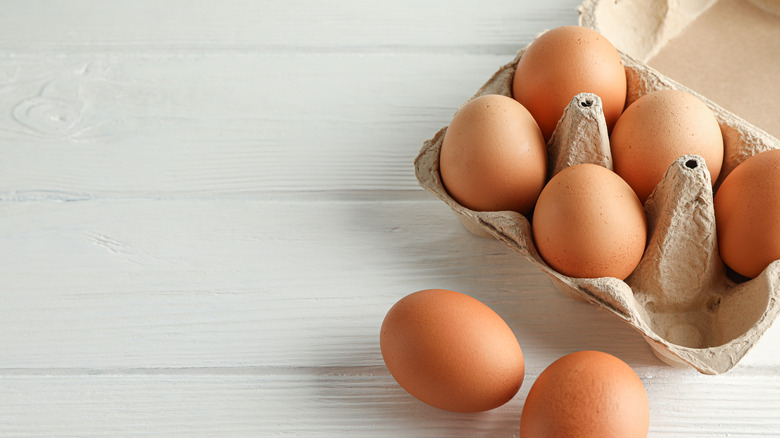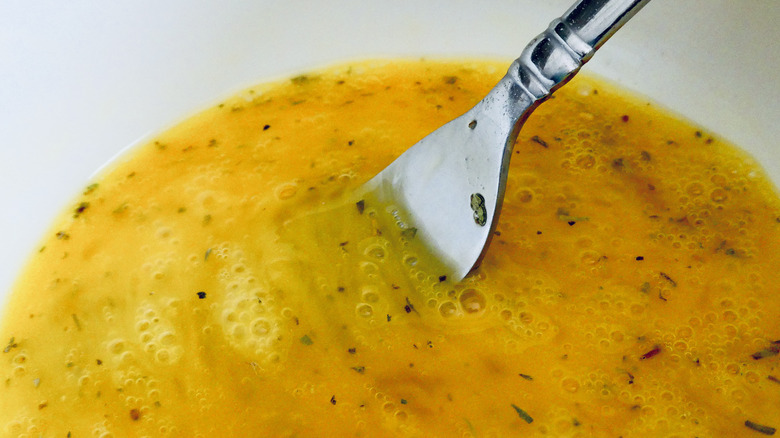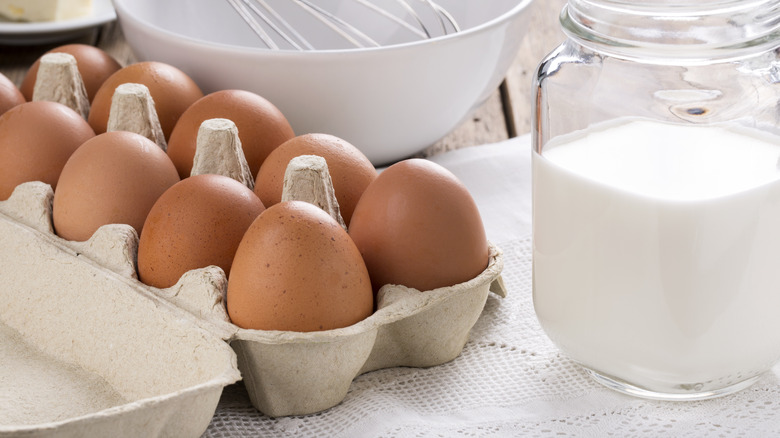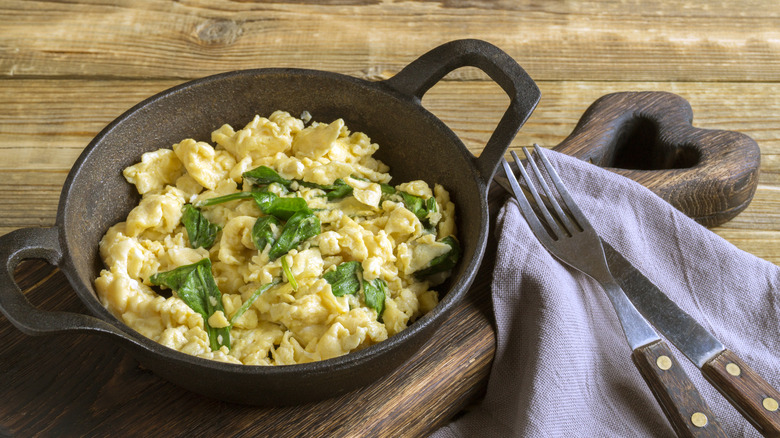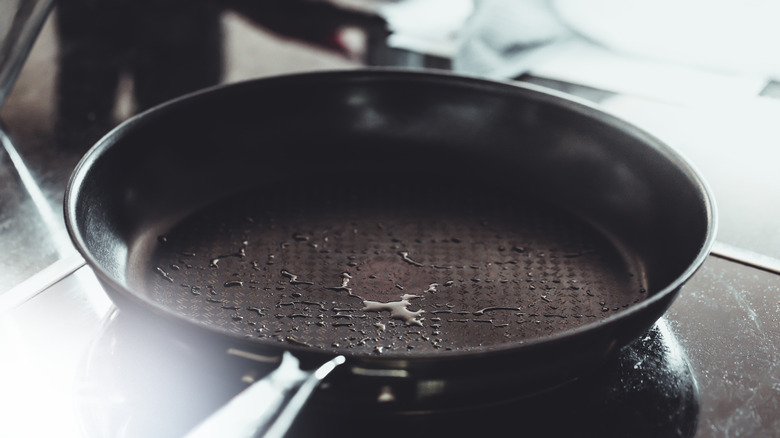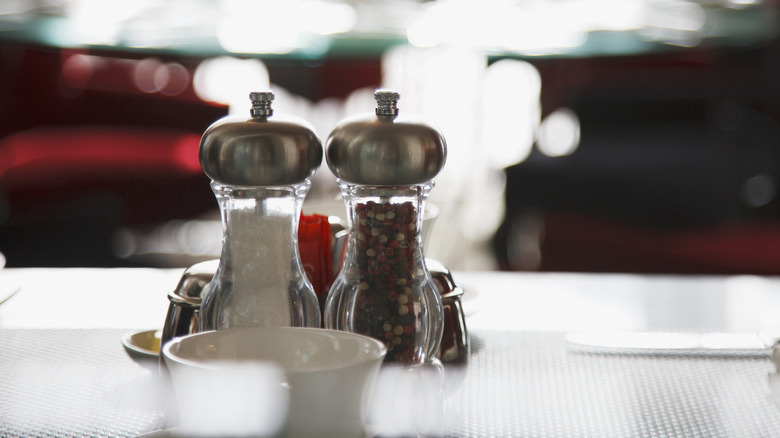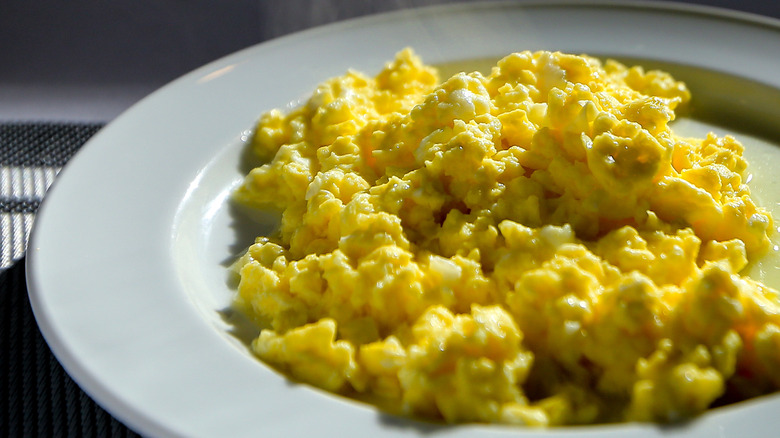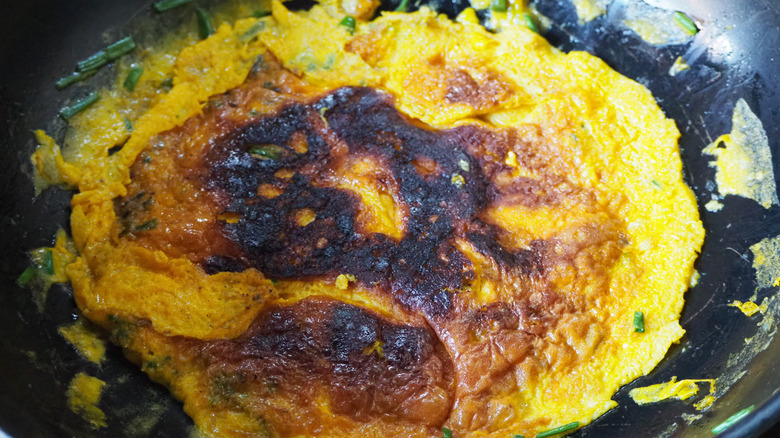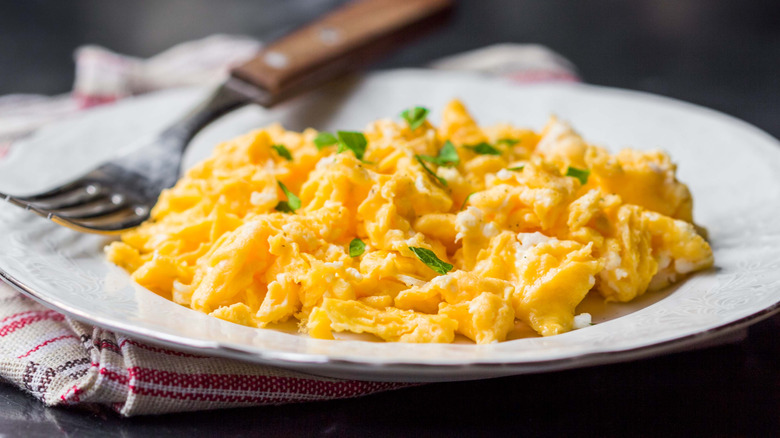Stop Making These Classic Scrambled Eggs Mistakes
There are a few techniques that every aspiring home cook should master because they involve methods that translate into various areas of cooking. For example, learning to make scrambled eggs — not just any scrambled eggs, but perfectly fluffy and flavorful scrambled eggs — is a skill that will take you far. As Stephen Johnson notes on Lifehacker, "Eggs are nature's cooking school in a shell, a pathway to teaching yourself everything you need to know to become a passable home cook."
So, what exactly are we aiming for when it comes to cooking the best scrambled eggs? Really good scrambled eggs have a creamy fluffy texture with large curds. They should have a rich buttery flavor, and the taste of the egg itself should come through (which means using the freshest eggs possible — but we'll get to that soon). Perfectly scrambled eggs should be pale yellow in color, not browned.
The trickiest part is reaching the ideal stage when the eggs are evenly cooked and creamy, certainly not overcooked and rubbery. It's a delicate balance, but one every cook can master with time and practice. Avoid these common mistakes, and you'll be well on your way to making amazing scrambled eggs every time.
Storing eggs incorrectly and not getting them fresh
Using fresh eggs is vital to making the best scrambled eggs. Part of ensuring your eggs are fresh is storing them properly. Start by keeping them in the carton to protect them from damage and prevent contamination.
Another important factor is to refrigerate them. Although eggs from a farmers market or from your own chickens can generally be stored on the counter, those bought at a grocery store need to be refrigerated. During the packaging process egg suppliers wash the shells, removing the protective coating that would normally keep bacteria out of the egg (via Successful Farming). The temperature in the refrigerator helps keep the eggs fresh for longer. It's important to keep the carton in the coldest part of the refrigerator — typically the back — to maintain freshness.
Finally, you should aim to use eggs within three to five weeks of the purchase date. If you're not sure how fresh they are, there are two ways to test them. Try the float test by filling a bowl with water and placing the eggs inside. A fresh egg will sink to the bottom, and an older egg will float. Another method is to crack the egg into a bowl and look at the yolk. According to Delishably, the yolk of a fresh egg will stand firmly above the white. If the white covers the yolk and the yolk looks sort of flat and sad, the egg isn't fresh.
Using the wrong utensil to mix the eggs
Breaking the yolks and mixing them with the whites is an essential step to making scrambled eggs, and it should be done before you add them to the pan. Does it really matter what utensil you use to mix them? Actually, it does. According to a video by Fine Dining Lovers, using a fork to scramble eggs is the best method for achieving perfectly fluffy and evenly cooked eggs every time.
When you use a whisk to scramble eggs, the whites and yolks are beaten together rapidly, which creates large air bubbles and causes them to become too frothy. This results in a less smooth and less creamy texture. On the other hand, using a fork to scramble eggs allows for a gentler mixing of the whites and yolks, ultimately resulting in a more uniform consistency and smaller more evenly distributed air bubbles.
Adding too much liquid to the eggs
One of the most common mistakes people make when cooking scrambled eggs is adding too much liquid. This can result in eggs that are watery, overcooked, and lacking in flavor. The excess liquid causes the eggs to steam instead of sauté, which can result in a rubbery texture. Additionally, the eggs will lose their yellow color and become pale and unappealing.
The excess liquid can also dilute the flavor of the eggs, making them taste bland and unappetizing. Additionally, if you are adding milk or cream to your scrambled eggs, too much liquid can cause the eggs to separate and curdle, leaving you with a lumpy and unappealing texture.
The key to making perfect scrambled eggs is to add just enough liquid to prevent the protein in the eggs from binding too tightly, according to culinary scientist Jessica Gavin. A small amount of milk or cream can be added for richness, but it's important to use it sparingly.
Using a pan that's too large
When making scrambled eggs, it's important to use an appropriately-sized pan. If it's too large, the eggs will spread out and cook unevenly since they will be thin and overcooked in some areas and undercooked in others. Ultimately, your eggs will end up with a rubbery texture and lacking flavor.
As well, using a pan that is too large can cause the eggs to cook too quickly, which can make them dry out (via Jessica Gavin). A pan that is too big also makes it difficult to control the temperature because the heat is distributed over a greater area, making it harder to maintain consistency. This can also cause the eggs to cook unevenly, resulting in a subpar texture.
The best size pan for scrambled eggs is one that is just big enough to accommodate the eggs without overcrowding. A small non-stick skillet or omelet pan is ideal since it allows for proper heat distribution and easy stirring. Gavin recommends an 8-inch pan for two to three eggs, giving you plenty of room to stir them but not so much that they cook too quickly for soft curds to form.
The pan is too hot
One common mistake that can ruin your scrambled eggs is cooking them over high heat. The eggs will cook too quickly, leading them to become overcooked with a rubbery texture. Also, the heat can cause the eggs to brown and even burn, which not only affects the taste but also the appearance of your eggs.
Another issue with too much heat is that the eggs can dry out since they lose moisture too quickly. A pan that is too hot can also cause the eggs to stick, making it difficult to flip and stir them. Again, this can result in uneven cooking and a less-than-perfect texture.
To ensure that your scrambled eggs turn out perfectly, it's important to use a pan heated to the right temperature. A medium-low heat is best for scrambled eggs, according to chef J. Kenji López-Alt (per The New York Times), since it allows the eggs to cook slowly and evenly, producing a creamy and flavorful texture.
Seasoning too soon
If you salt scrambled eggs too soon before they have a chance to cook, the salt can draw out moisture, resulting in a watery texture. This can make the eggs seem less flavorful than they would have been otherwise. Additionally, if you are using other seasonings such as herbs or spices, they may lose some of their aromas or burn as they cook in the pan.
Another issue with seasoning scrambled eggs too early is that it can cause the eggs to stick to the pan. Salt makes the proteins in eggs solidify more rapidly, which can make it difficult to flip and stir the eggs, resulting in uneven cooking and sticking.
It's best to wait until the eggs are nearly cooked before seasoning them. According to Sauder's Eggs, if you want fluffy scrambled eggs, hold off on salting them until the end of the cooking process. Adding salt before they start cooking will cause them to break down too quickly, making them watery.
It's a good idea to add your seasonings right before the eggs are done cooking, or even after you have plated them. This way you can ensure that they are well distributed and the flavor is nicely balanced.
Ineffective stirring techniques
The best way to stir scrambled eggs in the pan is to use a rubber or silicone spatula, chef and culinary director Maggie Trujillo tells Self. You should also stir gently and constantly while the eggs cook; however, it's not a bad idea to let them set for a minute or so in the pan before you start. This allows large curds to start forming, which is exactly what we're looking for. The key is to keep the heat on a medium-low setting to allow the eggs to set without burning.
When stirring, you should start at the bottom of the pan and scrape the eggs as they cook. This will prevent the eggs from sticking to the pan and help them cook evenly. You can also use a folding motion, where you lift and fold the eggs over themselves, rather than stirring in a circular motion. This will help create large, fluffy curds. With this method, the eggs will cook slowly and allow the proteins to set gently, ultimately resulting in a creamy and tender texture.
Under seasoning
Under seasoning scrambled eggs can result in eggs that lack flavor and are less enjoyable to eat. Upgrading scrambled eggs with the right seasonings can instantly take your eggs from meh to marvelous.
There are many ingredients that can be used to add flavor to scrambled eggs. In addition to the essential salt and pepper, consider adding fresh herbs like parsley, chives, cilantro, or dill. Spices such as cumin and paprika are classics too. Meanwhile, a dash of hot sauce is great if you like a bit of spice, and for an unexpected zing, consider squeezing lemon juice on your scrambled eggs.
But why stop there? To truly gild the lily, add cheese such as grated Parmesan, cheddar, or feta for a rich texture and even more flavor. Consider caramelizing onions ahead of time to add to your eggs. The key is to play with flavors to make scrambled eggs so good you'll want them at every meal.
Leaving the pan on the heat too long
Overcooking is one of the most common mistakes when it comes to scrambled eggs, and it's often due to what follows after you're done cooking them. You can do everything right, from using the freshest eggs, seasoning correctly, and using the optimal temperature and technique, and still end up with overcooked eggs if you neglect this final detail: Remove your pan from the heat just before the eggs are finished cooking.
Scrambled eggs should be removed from the heat when they are still slightly undercooked. This is because they will continue to cook due to residual heat in the pan and from the eggs themselves. The best way to determine when the eggs are done is to look at the consistency. They should be cooked through but still moist and creamy. If they are dry, rubbery, or hard you've overdone them.
Another way to tell if the eggs are ready is by the color; they should be pale yellow and not too browned. Take them off the heat before they look completely done, stir them a few times, then serve a plateful of perfectly fluffy eggs.
Forgetting to add this ingredient for tender, creamy scrambled eggs
Most scrambled egg fans agree that a creamy, light texture is the ultimate goal. As we've seen throughout this article, there are many ways a pan of scrambled eggs can go wrong. But there's one way to ensure that your eggs turn out perfect, even if you don't do everything else perfectly. The trick is to prepare a simple slurry and add it to the eggs as they're cooking.
Many home cooks are familiar with slurries for thickening sauces or gravies. The same idea holds true when it comes to using a slurry to create the perfect plate of scrambled eggs. A mix of water and starch — cornstarch, potato starch, or tapioca all work — added to the egg mixture provides a more forgiving environment overall. If you tend to overcook eggs, the added moisture from the slurry can prevent dry scrambled eggs. And if your eggs always seem to fall flat, the starch will give them some body and lightness.

